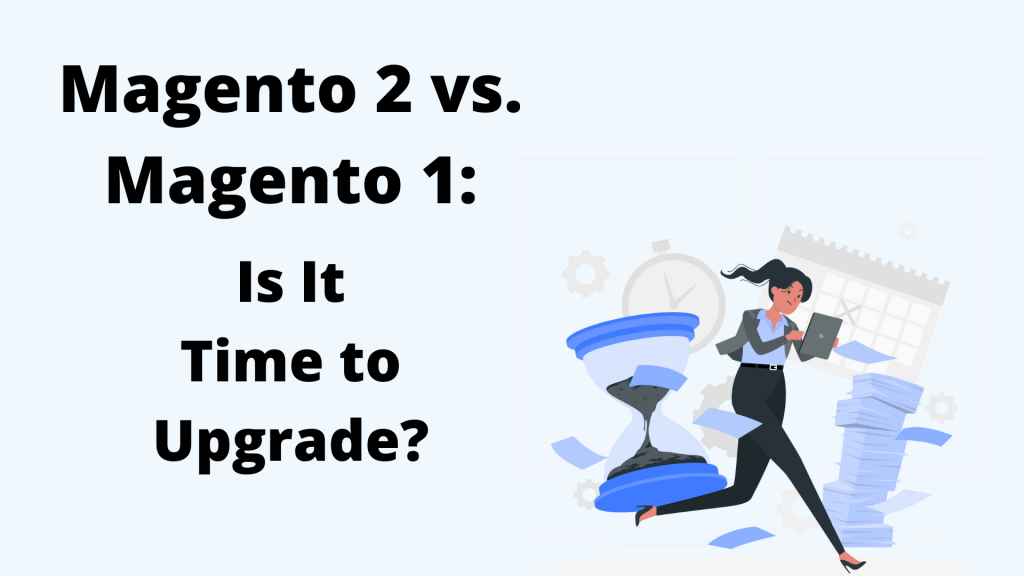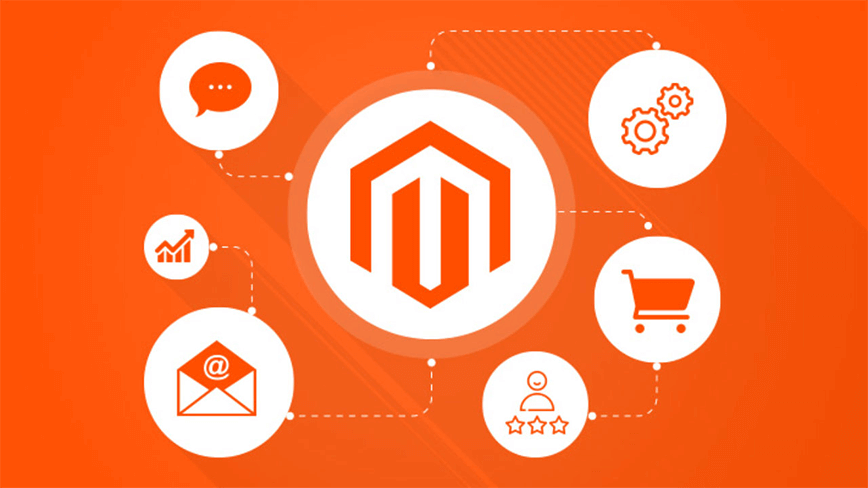
Magento 1 and Magento 2 are two versions of the popular ecommerce platform, each with its own set of features and advantages. There are several key differences between Magento 1 and Magento 2 that make it worthwhile to consider upgrading to the newer version.
One major difference is in the architectural changes. Magento 2 has a modular architecture, allowing developers to easily customize and extend the platform. Additionally, Magento 2 supports newer PHP versions, including PHP 7. This results in improved performance and efficiency, as PHP 7 offers significant speed improvements over previous versions.
Another important update in Magento 2 is the incorporation of browser caching and fullpage caching by default. This reduces server load and improves the loading speed of web pages, enhancing the overall user experience.
Magento 2 also includes updates to the framework, offering better scalability and stability. This makes it easier to handle increased traffic and large catalogs on your online store.
Overall, Magento 2 provides improved performance, efficiency, and scalability compared to Magento 1. With its updated architecture, support for newer PHP versions, enhanced caching capabilities, and framework updates, Magento 2 is undoubtedly a more advanced and robust ecommerce platform. It is indeed time to consider upgrading to Magento 2 for better results and success in your online retail business.
Key Differences Between Magento 1 and 2
When it comes to choosing the right eCommerce platform for your online store, it's important to consider the key differences between Magento 1 and Magento 2. While both versions offer powerful features and functionalities, Magento 2 introduces several significant updates and improvements. From architectural changes to performance enhancements, these differences can greatly impact your business's success. In this article, we will explore the key differences between Magento 1 and 2 and discuss why it might be time for an upgrade. Whether you're looking for improved performance, increased scalability, or enhanced user experience, understanding the distinctions Import Template between Magento 1 and 2 will help you make an informed decision and ensure your online store continues to thrive in the evolving eCommerce landscape.
Core Code
When it comes to upgrading from Magento 1 to Magento 2, addressing the core code is of utmost importance. The core code is the foundation of the platform and contains the essential functionalities that power your online store. Upgrading to Magento 2 allows you to take advantage of improved performance, security patches, and advanced technologies.
During the upgrade process, it is crucial to carefully evaluate and modify the custom code that has been developed for your Magento 1 store. While some custom code may be compatible with Magento 2, others will require rewriting or modification to ensure seamless integration. This is because Magento 2 introduces new features and a different code structure that may not be fully supported by the existing custom code.
Additionally, it is essential to check the compatibility of extensions, themes, and custom data during the upgrade. Third-party extensions are a vital component of any Magento store, and ensuring that they are compatible with Magento 2 is crucial for a smooth transition. Themes may also require adaptation or replacement to match the new version.
Taking the time to address the core code, evaluate custom code compatibility, and ensure the compatibility of extensions, themes, and custom data will result in a successful upgrade from Magento 1 to Magento 2. It will not only provide improved performance and security but also a seamless and enhanced experience for both you and your customers.

Performance and Efficiency
Magento 2 offers significant performance improvements compared to its predecessor, Magento 1. These enhancements include faster load times, improved indexing efficiency, compatibility with PHP 7, and built-in support for Redis and Varnish.
One of the key advantages of Magento 2 is its improved performance. With optimized code and a more efficient architecture, Magento 2 websites experience faster load times, resulting in a better user experience. This is especially crucial for online stores, as research shows that customers are more likely to abandon a website if it takes more than a few seconds to load.
Another important aspect of performance is indexing efficiency. Magento 2 has a new indexer that enables faster updates and better query performance. This means that changes made to product attributes or categories are reflected more quickly, allowing for a more seamless and real-time browsing experience for customers.
Furthermore, Magento 2 is compatible with PHP 7, which is known for its significant performance improvements over PHP 5. This compatibility ensures that Magento 2 can fully leverage the benefits of PHP 7's enhanced speed and resource usage optimization.
Lastly, Magento 2 has built-in support for popular caching technologies like Redis and Varnish. Redis in-memory caching improves the speed of data retrieval, while Varnish HTTP accelerator helps in delivering content quickly to users. These technologies enhance the overall performance and responsiveness of the online store, resulting in faster page loads and reduced server response times.
In conclusion, Magento 2's improved performance, faster load times, efficient indexing, PHP 7 compatibility, and support for Redis and Varnish contribute to a more efficient and responsive online store. These enhancements ensure a smooth and seamless browsing experience for customers, increasing customer satisfaction and ultimately boosting sales.
Security Patches
Security patches are crucial for the protection of any e-commerce platform, including Magento 1. With the constant evolution of cyber threats, regularly updating your Magento 1 installation with security patches is essential to maintain a secure online store. These patches address vulnerabilities identified by the Magento security team and help protect your website from potential attacks.
However, Magento 1 is now an unsupported version, which means that it will no longer receive security patches or regular updates. This puts online stores still using Magento 1 at a high risk of being hacked or compromised. Hackers actively look for vulnerabilities in outdated software and exploit them to gain unauthorized access to sensitive customer information, such as payment data and personal details.
In contrast, Magento 2 offers improved security features and regular updates that help protect your online store from emerging threats. It incorporates advanced security measures, such as improved password hashing algorithms (SHA-256), which enhance the security of customer information and make it more difficult for hackers to decrypt passwords.
Additionally, Magento 2 provides robust security suites that offer comprehensive protection against common security risks, such as SQL injection attacks and cross-site scripting. These suites help safeguard your website and ensure the integrity and confidentiality of customer data.
To ensure the security of your online store and protect your customers, it is highly recommended to upgrade from Magento 1 to Magento 2. Upgrading to Magento 2 not only provides enhanced security features but also ensures that your website receives regular security updates to stay protected against evolving threats.
Third-Party Extensions
One of the key factors that contributed to Magento 1's popularity was its extensive range of third-party extensions. These extensions allowed online store owners to customize and enhance their websites with additional features and functionality. However, with the end of life for Magento 1, the reliance on third-party extensions becomes a limitation.
After reaching end of life, Magento 1 will no longer receive updates or security patches. This means that any third-party extensions used on a Magento 1 store will also not receive updates or compatibility fixes. This can lead to compatibility issues, security vulnerabilities, and conflicts with the core code of the platform.
In contrast, Magento 2 offers an improved installation and update process for extensions. With the Magento Marketplace, store owners can easily find and install extensions that are compatible with their version of Magento 2. The platform also provides regular updates and compatibility checks for extensions, ensuring a smooth and secure experience.
By migrating from Magento 1 to Magento 2, store owners can benefit from improved security, performance, and a wider range of supported extensions. This not only helps to future-proof their online stores but also ensures a better overall experience for their customers.

Admin Panel
The admin panels in Magento 1 and Magento 2 have significant differences in terms of user experience and functionality. Magento 1's admin panel is straightforward and easy to use, but it suffers from an outdated design and slower loading times.
In contrast, Magento 2's admin panel is more intuitive and user-friendly. The interface has been redesigned to provide a cleaner and more modern look, making it easier for store owners and administrators to navigate and manage their online stores. The menu and navigation have been improved, allowing users to find the desired features and settings more quickly.
Additionally, Magento 2's admin panel offers faster loading times, providing a more efficient and responsive experience. This improvement in performance contributes to increased productivity and overall satisfaction for users.
Overall, while Magento 1's admin panel is functional, its outdated design and slower loading times can hinder the user experience. Magento 2's admin panel, on the other hand, offers a more intuitive and user-friendly interface, resulting in improved navigation and efficiency for managing online stores.
Search Engine Rankings & Rich Snippets
One of the key areas where Magento 2 surpasses its predecessor is in search engine rankings. Magento 2 incorporates advanced SEO features that can significantly impact the visibility of online stores in search engine results.
One important element that contributes to this is the use of rich snippets. Rich snippets are additional pieces of information that appear in search engine results, providing users with quick insights into the content of a webpage. By utilizing rich snippets, Magento 2 enables online store owners to enhance their listings, making them more appealing and engaging to potential customers. This increased visibility can ultimately lead to higher click-through rates and improved search engine rankings.
Moreover, Magento 2 improves SEO through its mobile optimization capabilities. With the increasing use of mobile devices for online shopping, it is crucial for websites to be mobile-friendly. Magento 2 offers responsive themes that automatically adjust to different screen sizes, providing users with a seamless experience regardless of the device they are using. Additionally, Magento 2 addresses duplicate content issues by implementing canonical tags and Meta tags, ensuring that search engines recognize the original source of content and avoid penalizing the website for duplications.
Improved search engine rankings have several benefits for online store owners. Firstly, higher rankings result in increased visibility, driving more organic traffic to the website. This influx of visitors can lead to higher sales and conversions. Additionally, improved search engine rankings boost customer engagement, as it increases the likelihood of users finding the website when searching for relevant products or services. Overall, the SEO enhancements in Magento 2 can have a significant impact on the success and profitability of online stores.
Benefits of Upgrading to Magento 2
If you are currently using Magento 1 for your online store, it may be time to consider upgrading to Magento 2. There are several key benefits that come with making the switch. One of the most significant advantages is the improved performance that Magento 2 offers. With faster load speeds and instant server response times, your online store can provide a seamless and efficient customer experience. Additionally, Magento 2 comes with advanced technologies such as Progressive Web Apps (PWA) and Percona 5.6, which further enhance performance and speed. Another benefit is the improved security that Magento 2 provides. With regular updates and security patches, your online store will be better protected against potential threats and vulnerabilities. Moreover, Magento 2 offers a comprehensive dashboard and an improved admin panel that make managing your online store easier and more efficient. With all these advantages, upgrading to Magento 2 can greatly enhance your online store's performance, security, and overall customer satisfaction.
Improved Performance & Efficiency
Magento 2 brings several key performance improvements over its predecessor, Magento 1. One of the most notable improvements is faster load times. With enhanced caching mechanisms and optimized coding structure, Magento 2 ensures that your online store loads quicker, providing a smoother user experience.
In terms of indexing efficiency, Magento 2 has made significant strides. It introduces a new indexer that reduces the time it takes to index products and categories. This not only saves valuable resources but also allows your online store to handle larger volumes of traffic without any performance issues.
Furthermore, Magento 2 leverages the power of PHP 7, the latest version of PHP, to deliver better performance gains. PHP 7 significantly improves the processing speed of web applications, resulting in reduced server response times and improved overall performance.
To further boost performance, Magento 2 provides built-in support for Redis and Varnish. Redis, an in-memory data structure store, enhances the speed and performance of your online store by caching frequently accessed data. Varnish, on the other hand, is a powerful HTTP accelerator that helps reduce the load on your server by caching dynamic content.
Lastly, Magento 2 introduces different deployment modes for optimal production performance. It allows you to choose between 'default' mode for immediate development, 'production' mode for maximum performance, and 'developer' mode for easier debugging.
With these performance improvements, Magento 2 proves to be a worthy upgrade for online store owners looking to enhance their website's speed, efficiency, and overall performance.

Optimized Checkout Process for Customers
With the optimized checkout process in Magento 2, customers can enjoy a seamless and hassle-free experience. One of the key improvements compared to Magento 1 is the simplified registration process. In Magento 2, customers can choose to create an account or proceed as a guest, eliminating the need for lengthy registration forms.
Additionally, Magento 2 reduces the number of forms customers have to fill in during checkout. By streamlining the process and removing unnecessary steps, customers can quickly enter their shipping and payment information, saving time and reducing the risk of cart abandonment.
Another enhancement in Magento 2 is the addition of checkouts at each step. This feature allows customers to conveniently review and edit their information, ensuring accuracy and minimizing mistakes.
Furthermore, Magento 2 offers improved PayPal integration, enabling a smoother and more secure payment process. Customers can now complete their transactions seamlessly with just a few clicks.
To provide a clearer overview, Magento 2 presents an order summary with product photos. This visual representation helps customers easily confirm their purchases and enhances the overall shopping experience.
In conclusion, the optimized checkout process in Magento 2 offers simplified registration, fewer forms to fill in, checkouts at every step, improved PayPal integration, and an order summary with product photos. These features contribute to a seamless and efficient checkout experience, enhancing customer satisfaction and reducing cart abandonment.
More Effective Search Terms & Keywords
Magento 2 offers several improvements in its SEO features, providing merchants with the tools to boost their search engine rankings and drive more organic traffic to their online stores.
One of the key enhancements is the integration of Schema.org and rich snippets. Schema.org provides a standardized way to structure data on web pages, helping search engines understand the content better. Rich snippets, on the other hand, display additional information in the search results, such as product ratings, reviews, and price range. By utilizing Schema.org and rich snippets, merchants can enhance their search listings, increase click-through rates, and improve visibility on search engines.
Additionally, Magento 2 allows merchants to easily tweak the SEO settings for individual products. This includes customizing meta titles, descriptions, and URLs for each product. By optimizing these elements with relevant keywords and descriptive information, merchants can improve the visibility and clickability of their product pages in search results. Furthermore, Magento 2's SEO-friendly URLs automatically include the product name, making them more user-friendly and accessible to search engine crawlers.
Overall, these improvements in Magento 2's SEO features enable merchants to leverage more effective search terms and keywords, leading to improved search engine rankings and increased visibility for their online stores.
Easier Product Images Management
Magento 2 offers a significant improvement in product image management compared to its predecessor, Magento 1. With Magento 2, administrators have the ability to easily upload not just product images, but also promotional videos. This feature allows merchants to enhance the product listings on their online stores by showcasing videos alongside the images.
The clean and user-friendly admin interface of Magento 2 further simplifies the process of managing product images. Even non-technical users can easily add new product listings and update existing ones with images and videos. The intuitive interface eliminates the need for extensive training or technical knowledge, enabling merchants to efficiently handle their online stores.
Another advantage of Magento 2 is its responsive web design. This means that the online store built on Magento 2 can be accessed through any computer or mobile device without compromising the user experience. With the increasing number of customers shopping on their smartphones, having a responsive website becomes crucial for any online business. Magento 2's responsive web design ensures that customers can seamlessly navigate and make purchases from the store, regardless of their device.
In conclusion, Magento 2 provides easier product image management through the ability to upload promotional videos. Its clean and user-friendly admin interface allows nontechnical users to effortlessly add new product listings. The responsive web design of Magento 2 ensures a user-friendly experience for customers accessing the store through any computer or mobile device.
Resolving the Duplicate Content Issue
The duplicate content issue is a common problem faced by online stores built on Magento 2. However, this issue can be easily resolved by implementing the Specify Grid feature in the Content Management Interface.
To resolve the duplicate content issue, administrators can follow these simple steps:
- Access the Content Management Interface in the Magento 2 admin panel.
- Navigate to the Pages section and select the desired page where the duplicate content needs to be resolved.
- In the page editor, locate and click on the Specify Grid button.
- This will bring up a grid view where administrators can define unique content for different sections of the page.
- By specifying distinct content for each section, administrators can ensure that there is no duplication across the page.
- Once the content has been specified for all sections, save the changes and the duplicate content issue will be resolved.
Implementing the Specify Grid feature in Magento 2 eliminates the need for additional CMS platforms like WordPress or Drupal. Administrators can now create and manage more Content pages directly within Magento 2, saving time and effort.
The Specify Grid feature offers several benefits, including better content management and improved SEO. Administrators can now easily organize and update content sections, ensuring a more cohesive and engaging user experience. Additionally, by eliminating duplicate content, search engines will index the website more effectively, resulting in improved SEO rankings.
In conclusion, resolving the duplicate content issue in Magento 2 is made simple with the implementation of the Specify Grid feature. Administrators can create and manage Content pages directly within Magento 2, saving time and improving SEO.
 Magento 1 and Magento 2 are two versions of the popular ecommerce platform, each with its own set of features and advantages. There are several key differences between Magento 1 and Magento 2 that make it worthwhile to consider upgrading to the newer version.
One major difference is in the architectural changes. Magento 2 has a modular architecture, allowing developers to easily customize and extend the platform. Additionally, Magento 2 supports newer PHP versions, including PHP 7. This results in improved performance and efficiency, as PHP 7 offers significant speed improvements over previous versions.
Another important update in Magento 2 is the incorporation of browser caching and fullpage caching by default. This reduces server load and improves the loading speed of web pages, enhancing the overall user experience.
Magento 2 also includes updates to the framework, offering better scalability and stability. This makes it easier to handle increased traffic and large catalogs on your online store.
Overall, Magento 2 provides improved performance, efficiency, and scalability compared to Magento 1. With its updated architecture, support for newer PHP versions, enhanced caching capabilities, and framework updates, Magento 2 is undoubtedly a more advanced and robust ecommerce platform. It is indeed time to consider upgrading to Magento 2 for better results and success in your online retail business.
Magento 1 and Magento 2 are two versions of the popular ecommerce platform, each with its own set of features and advantages. There are several key differences between Magento 1 and Magento 2 that make it worthwhile to consider upgrading to the newer version.
One major difference is in the architectural changes. Magento 2 has a modular architecture, allowing developers to easily customize and extend the platform. Additionally, Magento 2 supports newer PHP versions, including PHP 7. This results in improved performance and efficiency, as PHP 7 offers significant speed improvements over previous versions.
Another important update in Magento 2 is the incorporation of browser caching and fullpage caching by default. This reduces server load and improves the loading speed of web pages, enhancing the overall user experience.
Magento 2 also includes updates to the framework, offering better scalability and stability. This makes it easier to handle increased traffic and large catalogs on your online store.
Overall, Magento 2 provides improved performance, efficiency, and scalability compared to Magento 1. With its updated architecture, support for newer PHP versions, enhanced caching capabilities, and framework updates, Magento 2 is undoubtedly a more advanced and robust ecommerce platform. It is indeed time to consider upgrading to Magento 2 for better results and success in your online retail business.





